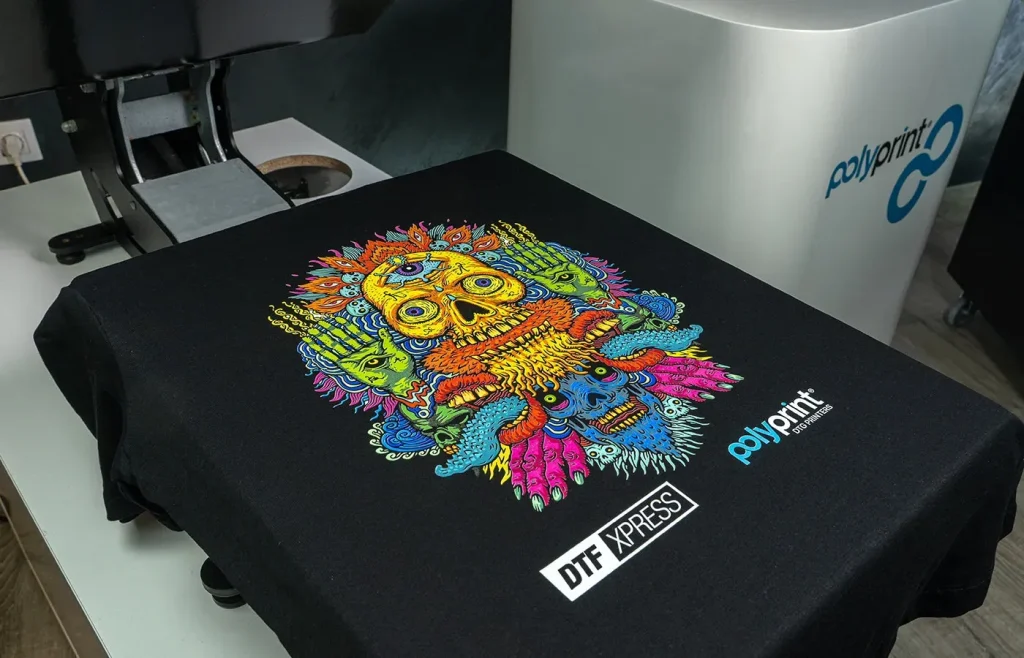DTF printing, or Direct-to-Film printing, is revolutionizing the textile printing industry by offering a dynamic approach to custom apparel printing. This innovative process allows designers to transfer intricate designs onto fabric with remarkable detail and durability. Unlike traditional methods, the DTF transfer process eliminates the need for pre-treatment, making it a versatile choice for various materials, including cotton, polyester, and leather. By tapping into eco-friendly printing methods, DTF printing not only enhances the quality of prints but also appeals to environmentally conscious consumers looking for sustainable options. In this guide, we will delve deeper into the numerous DTF printing advantages that make it an attractive solution for businesses of all sizes.
As the name suggests, Direct-to-Film (DTF) printing represents an advancement in the field of fabric decoration, where images are printed directly onto a specialized film. This modern printing technique is particularly effective in custom apparel production due to its ability to create vibrant and long-lasting images on a variety of substrates. The DTF transfer method is gaining popularity for its efficiency and its compatibility with eco-friendly practices, appealing to those seeking sustainable custom printing solutions. By using the latest technology in direct-to-film techniques, businesses can achieve high-quality results while enjoying the benefits of cost-effectiveness and versatility in their printing projects. This comprehensive overview will explore the various applications and benefits of DTF printing in today’s market.
Understanding Direct-to-Film Printing: The Basics
Direct-to-Film printing, or DTF printing, is a cutting-edge technique that has revolutionized the textile industry through its innovative approach to printing designs. Unlike traditional methods that require extensive preparation, DTF allows for direct application on a variety of substrates by printing onto a special film, which is then transferred onto fabric. This process not only simplifies production but also enhances the quality, making it an attractive option for both small businesses and large manufacturers.
The DTF transfer process eliminates the need for pre-treatment of materials, giving it incredible flexibility in application across different types of fabrics like cotton and polyester. This adaptability makes DTF printing suitable for various products, from custom apparel to promotional items, paving the way for limitless creative possibilities in textile printing.
The Unique Advantages of DTF Printing
DTF printing offers several compelling advantages that set it apart from conventional printing techniques. One of the primary benefits is its cost-effectiveness, particularly for small to medium-sized runs. Unlike screen printing, which often incurs hefty setup costs, DTF requires minimal investment in terms of film and transfer materials, making it a financially viable solution for custom apparel needs.
Furthermore, the durability of DTF-printed designs is noteworthy. The prints exhibit excellent resistance to washing and fading, ensuring that colors remain vibrant over time. This level of durability makes DTF ideal for creating long-lasting apparel that can withstand the rigors of daily wear, which is essential for brands looking to deliver quality products that resonate with consumers.
Applications of DTF Printing in Custom Apparel
The applications of DTF printing are expansive, particularly in the realm of custom apparel. This technique allows businesses to offer personalized clothing options that resonate with individual customer preferences, such as unique t-shirts and hoodies. These custom items can be tailored with logos, graphics, or text, providing an authentic and personal touch that appeals to consumers.
Additionally, DTF printing is increasingly being utilized for promotional products. Businesses are turning to this technique to create custom bags, caps, and other merchandise that effectively communicate their brand identity. Whether for a giveaway or as part of a marketing campaign, DTF printing provides an excellent way for companies to enhance visibility and engage customers.
Recent Technological Advancements in DTF Printing
Recent advancements in DTF printing technology have significantly enhanced the efficiency and quality of print production. New printers specifically designed for DTF processes are emerging, capable of producing high-resolution images faster than ever. Additionally, innovations in ink formulations are improving the vibrancy and longevity of prints, ensuring that designs maintain their appeal even after repeated use.
These technological advancements are not only streamlining production but also expanding the creative potential of custom apparel. With quicker turnaround times and improved print quality, businesses can now meet consumer demands more effectively, positioning themselves competitively in the growing customization market.
Sustainability in DTF Printing: Eco-Friendly Practices
As sustainability becomes increasingly important in the textile industry, DTF printing is gaining traction for its reduced environmental impact. Compared to traditional printing processes that often require extensive water and energy resources, DTF printing technology consumes significantly less. This efficiency is appealing to businesses looking to implement eco-friendly practices in their operations.
Furthermore, there is a growing movement towards the use of eco-friendly inks and recyclable materials in DTF printing. Companies are actively seeking out sustainable options, which not only cater to the environmentally conscious consumer base but also position themselves as forward-thinking brands that prioritize corporate social responsibility.
The Future of DTF Printing in the Textile Industry
The future of DTF printing looks promising as innovations continue to emerge in both technology and market application. As more businesses adopt this method, we can expect to see a shift in how companies approach printing, with an emphasis on customization and personalization. DTF printing is well-positioned to become a staple for brands seeking to differentiate themselves in a competitive marketplace.
As market demand for customized and high-quality printed items grows, the role of DTF printing is likely to expand further. With ongoing investments in technology and a focus on sustainability, DTF printing could redefine the textile printing landscape, ushering in new standards for quality, efficiency, and eco-friendliness.
Frequently Asked Questions
What is DTF printing and how does it work?
DTF printing, or Direct-to-Film printing, involves printing designs onto a specialized film with an inkjet printer. After applying hot-melt adhesive powder to the wet ink, the film is heat-treated. The processed film is then transferred onto fabric using a heat press, enabling vibrant and detailed designs.
What are the main advantages of DTF printing compared to other methods?
DTF printing offers several advantages including versatility across various fabric types, cost-effectiveness for small runs, and durability of prints that remain vibrant even after multiple washes. These advantages make it a preferred choice over methods like Direct-to-Garment (DTG) printing.
Can DTF printing be used for custom apparel and promotional products?
Yes, DTF printing is highly suitable for custom apparel printing and promotional products. Its versatility allows brands to create unique clothing items, such as t-shirts and hoodies, as well as branded items like tote bags and hats with vibrant prints.
How does the DTF transfer process ensure quality and durability?
The DTF transfer process ensures quality by using high-resolution prints and applying a heat press to transfer the design securely onto fabric. This process, coupled with durable inks and adhesives, results in prints that withstand regular wear, washing, and fading.
Is DTF printing considered an eco-friendly printing method?
Yes, DTF printing is regarded as one of the eco-friendly printing methods due to its lower water and energy consumption compared to traditional techniques. Additionally, there are ongoing developments in eco-friendly inks and recyclable materials in the DTF printing process.
What recent developments are shaping the future of DTF printing?
Recent developments in DTF printing include advancements in printer technology, improved ink formulations for better durability and vibrancy, and a growing trend towards sustainability initiatives. These advancements position DTF printing as a leading solution in the customization market.
| Key Concept | Description |
|---|---|
| What is DTF Printing? | A printing method that transfers designs onto fabric using a special film and heat press. |
| Advantages of DTF Printing | Versatility, cost-effectiveness, and durability of prints. |
| Applications of DTF Printing | Used in custom apparel, promotional products, and specialty items. |
| Recent Developments | Technological advancements, market growth, and sustainability initiatives. |
Summary
DTF printing is revolutionizing the textile printing industry by offering a cutting-edge method that enhances fabric printing capabilities. This technique not only allows businesses to create highly customizable products but also emphasizes sustainability and efficiency, making it an ideal choice for modern printing needs. As DTF printing continues to evolve, it is set to play an integral role in shaping the future of custom apparel and promotional products, appealing to both brands and eco-conscious consumers.



